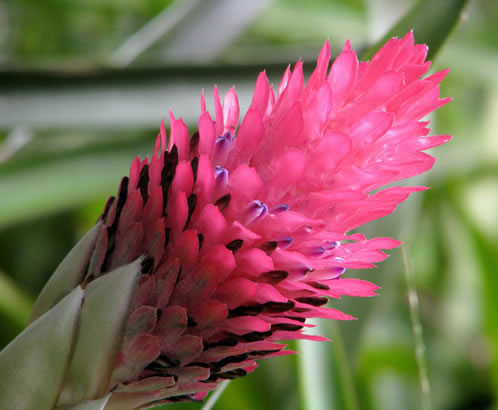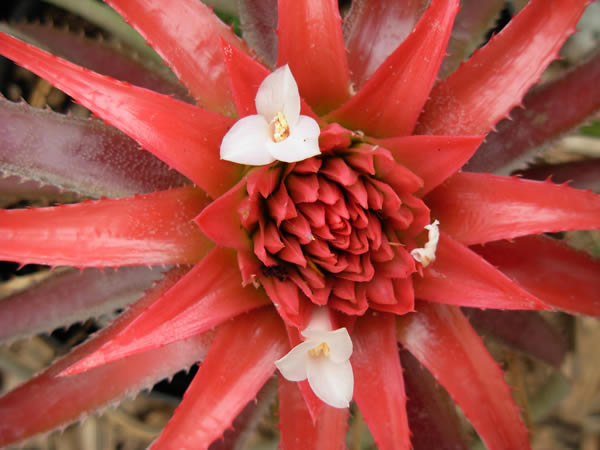 |
| Bromeliaceae |
The family Bromeliaceae comprises a group of perennial, monocotyledon herbs or trees that often age slowly.
Important ornamentals (called bromeliads) as well as sources of food and medicines, Bromeliaceae have substantial economic value and are widely cultivated. The colors of the leaves offer decorative foliage, and the flowers are of astonishing hues due to the rich content of pigment-forming substances known as anthocyanins.
Based on ovary position, habit, and floral and pollen morphology, the family Bromeliaceae has been split into three subfamilies: subfamily Pitcairnioideae, subfamily Tillandsioideae, and subfamily Bromelioideae.
  |
There are fifty-six genera and approximately twenty-six hundred species, growing mostly in the neotropical regions of the world, from Virginia to southern Argentina. One species, Pitcairnia feliciana, originated in Africa. This interesting family can nevertheless occupy a variety of ecologically diverse environments, ranging from the dry deserts in Peru to the highest montane forest in the Andes Mountains.
Appearance and Structure
The Bromeliaceae family shares a basic ground plan of construction that consists of branches (ramets) and an inflorescence that follows a repetitive pattern when growing. However, modifications, in the form of reductions, of this basic plan have evolved in different subfamilies.
The basic pattern consists of sympodial branching, a rhythmic type of growth in which the axis is built up by a linear series of shoot units, each distal unit developing from an axillary bud located on the previous shoot unit. This pattern of development leads to a series of condensed ramets with terminal flowers. Roots, when present, usually emerge from the lower half of each ramet.
Growing Habit
 |
| Tillandsia funckiana |
Bromeliaceae range from small plants, such as some miniature Tillandsia, to very tall individuals, such as Puya raimomndii, reaching up to 32 feet (10 meters) in height. They can be epiphytes, that is, plants that use other species as support without harming them, or terrestrial. Some grow on top of rocks, and some are carnivorous.
Those species whose leaves are born from a common place in the stem (in a rosulate shape) can develop the tank form, also known as phytotelma, that is common in genera such as Aechmea and Brocchinia.
These phytotelma harbor a variety of insects and small vertebrates that grow in small pools of water and old leaves that collect at the bottom of the “tank.” The tanks accumulate water and partially dissolved organic matter, creating a nutrient rich substrate as a continuous supply of moisture. Other Bromeliaceae do not form tanks; instead, they have fully functional roots and specialized hairs for water absorption.
Scales
 |
| Beautiful isn't it? |
Physiological adaptations to different environments among some species correlate with the presence of a highly evolved type of foliar hair (or trichome) known as a scale. The scales may cover the entire surface of the leaf, sometimes appearing in different locations and patterns; they absorb atmospheric water through capillary action, like blotting paper, and the water is later transported to the leaf tissue, where it is stored in the parenchyma.
Division of the scale in two parts—known as the shield, or trichome covering, and the water absorption cells—is what makes Bromeliaceae unique. When water is scarce the scale shrinks, and when water is present the shield cells expand. Scales protect the leaves against transpiration and reduce water evaporation during the dry periods.
Flowers and Pollination
 |
| Flowering bromeliaceae |
The flowers of Bromeliaceae are generally hermaphroditic (functionally unisexual). Their shape can be radial or slightly asymmetric, and the number of floral parts known as sepals and petals is always three. The stamen arrangement is in two whorls, with three stamens in each one. The ovary can be superior or inferior, and the placentation (position of the ovules) is mostly axial.
Septal nectaries are always present at the base of the flower. The sepals are distinguished from the petals by their color and size. The petals show bright colors, while the sepals may remain mostly in green hues. Fruits are usually a capsule or a berry, and the seeds are winged.
The bloom of Bromeliaceae flowers is usually odorless, although some species may have scented flowers, indicating pollination by nocturnal moths or butterflies. However, their abundant secretion of nectar indicates that the plants are pollinated primarily by birds.
Uses
The main uses of Bromeliaceae are as textile fiber, food, medicine, and ornamental plantings. In the food category the pineapple, Ananas comosus, is the most widely used species. The medicinal properties of pineapple are based on the presence of bromelain, a proteolitic (protein-breaking) enzyme that is widely used to treat inflammation and pain.
 |
| Pineapple, Ananas comosus |
Serotonin, a neurotransmitter, is also present, and steroids from the leaves possess estrogenic activity. Thirteen species of Bromeliaceae are used as a source of textile fibers; for example, hammocks are made from the fibers of Aechmea bracteata and of pineapple.